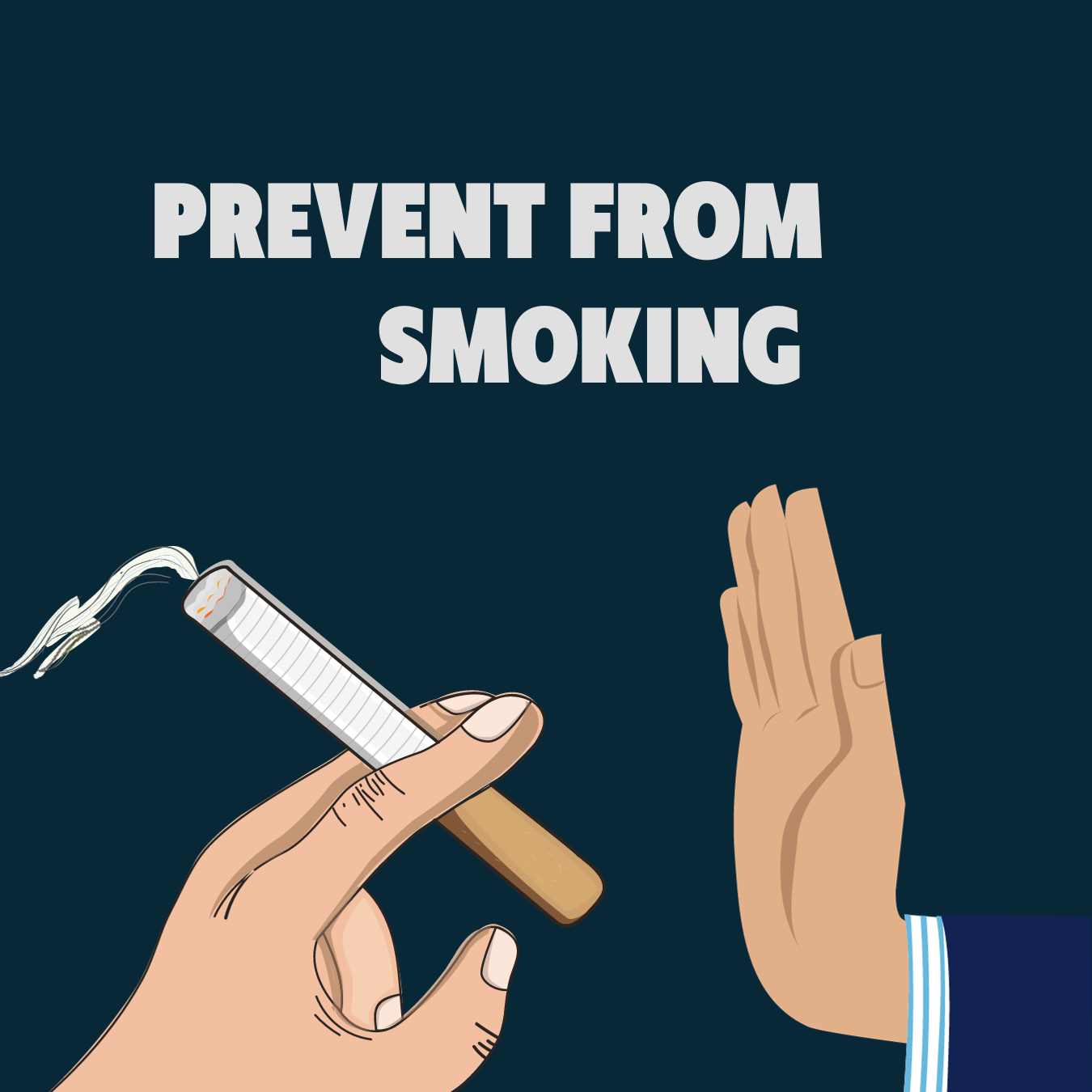To prevent from smoking, engage in evidence-based interventions that aim to reduce or delay the initiation of tobacco use and improve overall health. This includes quitting smoking as soon as possible to prevent or reverse potential health problems and adopting relaxation techniques, such as taking warm baths or practicing deep breathing exercises.
Additionally, seek medication and counseling for the most successful way to quit smoking. Avoiding tobacco use altogether is the most effective strategy for protecting oneself from harm.
Strategy 1: Understand The Risks And Consequences Of Smoking
Understanding the risks and consequences of smoking is a crucial strategy in preventing tobacco use. By educating oneself about the harmful effects of smoking on health and implementing evidence-based interventions, such as quitting smoking and gradually decreasing the number of cigarettes smoked each day, individuals can improve their health and reduce their risk of heart disease, cancer, and lung disease.
| Strategy 1: Understand the Risks and Consequences of Smoking |
| Familiarize yourself with the effects of smoking on health. Learn about the risks associated with smoking and understand the long-term consequences of smoking. Knowing the detrimental impact smoking can have on your health can serve as a strong motivator to quit or prevent smoking altogether. |
| Quitting smoking as soon as possible can prevent or reverse health problems. Without smoking, you can live longer and reduce your risk of heart disease, cancer, and lung disease. Gradually decreasing the number of cigarettes smoked per day can be an effective way to quit for some people. Additionally, engaging in relaxation techniques such as taking a warm bath, meditating, reading a book, or practicing deep breathing exercises can help manage cravings and reduce stress that may trigger the desire to smoke. |
| The most successful way to stop smoking is through a combination of medication and counseling. Seeking support from healthcare professionals and participating in tobacco treatment programs can significantly improve your chances of successfully quitting smoking. Remember, it’s never too late to quit smoking and improve your overall health. |
Strategy 2: Set Clear Goals And Motivate Yourself To Quit
| Strategy 2: Set Clear Goals and Motivate Yourself to Quit |
|
Identify your reasons for wanting to quit smoking: It is important to reflect on why you want to quit smoking. Whether it is for your health, the well-being of your loved ones, or to save money, having a clear understanding of your motivations will help you stay focused on your goal.
Set achievable goals for quitting: Instead of trying to quit smoking cold turkey, set small and attainable goals to gradually reduce your smoking habits. This can make the process more manageable and increase your chances of success.
Find motivation and support to stay committed to your goal: Surround yourself with supportive people who encourage your efforts to quit smoking. Join a support group, seek counseling, or use online resources to help you stay motivated and accountable. Additionally, celebrate milestones along the way to keep your spirits high and maintain your commitment to quitting smoking.
Strategy 3: Seek Professional Help And Support
Strategy 3: Seek Professional Help and Support – Get expert guidance and support to prevent smoking. Combining medication and counseling can significantly increase your chances of quitting. Seek assistance from professionals to improve your chances of success in your journey towards quitting smoking.
Consult with a healthcare professional for guidance and advice
|
Consider joining a support group or seeking counseling services
|
Explore available medications and treatments to aid in quitting
|


Credit: www.medicalnewstoday.com
Strategy 4: Develop A Quitting Plan
| Strategy 4: Develop a Quitting Plan |
Create a personalized quitting plan that suits your needs. Start by setting a quit date and make a commitment to stick to it. Identify triggers that make you crave cigarettes and develop strategies to overcome those cravings. Gradually decrease the number of cigarettes you smoke each day as an effective way to quit. Try to relax and engage in activities that calm you down, such as taking a warm bath or practicing deep breathing exercises.
Strategy 5: Make Lifestyle Changes
Adopting a healthy diet and exercising regularly can greatly improve your overall well-being. By nourishing your body with nutritious food and engaging in physical activity, you can strengthen your immune system, boost your energy levels, and reduce your risk of various health conditions. Incorporate plenty of fruits, vegetables, whole grains, and lean proteins into your diet, and try to avoid processed foods and sugary beverages. Additionally, finding alternative activities to replace smoking habits can be beneficial. Engage in hobbies or interests that occupy your time and distract you from the urge to smoke. Surrounding yourself with a smoke-free environment is also crucial. Ensure your home, car, and workplace are smoke-free zones to minimize the temptation. Taking small steps towards lifestyle changes can have a significant impact on your journey to quit smoking.
Strategy 6: Utilize Nicotine Replacement Therapy (nrt)
| Strategy 6: Utilize Nicotine Replacement Therapy (NRT) |
| Explore different NRT options such as patches, gum, or inhalers |
| Understand how NRT can help manage withdrawal symptoms |
| Follow the recommended dosage and usage instructions |
Utilizing nicotine replacement therapy (NRT) is an effective strategy to help you quit smoking. NRT provides a source of nicotine to the body without the harmful chemicals found in cigarettes. It helps manage withdrawal symptoms and cravings, making it easier to quit smoking. There are various NRT options available such as patches, gum, or inhalers. Each option has its own benefits and considerations, so it’s important to explore and find the one that works best for you. It’s crucial to follow the recommended dosage and usage instructions provided with the NRT product to maximize effectiveness and minimize potential side effects. NRT can be a valuable tool in your journey to quit smoking and improve your overall health.
Strategy 7: Practice Stress-management Techniques
Prevent from Smoking |
Learn effective stress-reducing techniques like meditation or deep breathing exercises
Find healthy ways to cope with stress instead of turning to smoking.
Try to relax – Do something that calms you down, such as taking a warm bath, meditating, reading a book, or practicing deep breathing exercises.
Quit gradually. Some people find that gradually decreasing the number of cigarettes they smoke each day is an effective way to quit. But this strategy doesn’t work for everyone.
The only proven strategy to protect yourself from harm is to never smoke, and if you do smoke or use tobacco products, to quit.
The best way to quit smoking is with a combination of medication and counseling. They both help. But you double your chances by using both compared with one of them.
Existing school-based smoking prevention programs do not work, but there are other effective strategies to reduce youth smoking.
Strategy 8: Stay Accountable And Track Your Progress
| Strategy 8: Stay Accountable and Track Your Progress |
|
To stay on track towards quitting smoking, it’s important to stay accountable and track your progress. One effective strategy is to keep a journal, where you can record your thoughts, experiences, and challenges as you work towards your goal of quitting smoking. This journal can serve as a valuable tool to reflect on your journey and remind yourself of the progress you have made. Additionally, monitoring and celebrating milestones and achievements along the way can provide motivation and encouragement to continue on your smoke-free path.
Furthermore, it’s important to stay connected with a support system. Having supportive friends, family, or a support group can help you stay accountable and provide you with the necessary encouragement and guidance throughout your quitting journey. By sharing your progress, challenges, and successes with others, you can build a network of support that can keep you motivated and focused on your goal of quitting smoking.
Strategy 9: Stay Positive And Overcome Relapses
One effective strategy to prevent smoking is to stay positive and overcome relapses. By maintaining a positive mindset and persevering through setbacks, individuals can successfully quit smoking and improve their overall health.
Stay Positive and Overcome Relapses
- Understand that quitting smoking is a process and setbacks may occur.
- Learn from each relapse and use it as an opportunity to grow stronger.
- Stay positive and motivated even during challenging times.
Quitting smoking is not easy, but it is possible with the right mindset and strategies. Understand that quitting smoking is a process, and relapses may happen along the way. Instead of getting discouraged, learn from each relapse and use it as an opportunity to grow stronger. Stay positive and motivated throughout your journey, even during challenging times. Remember that every small step counts, and each moment is an opportunity to make a positive change. With determination and a positive attitude, you can overcome any obstacles and successfully quit smoking for good. Stay confident in your ability to achieve a smoke-free life and embrace the process of becoming a healthier and happier individual.
Strategy 10: Reward Yourself And Celebrate Success
Rewarding yourself and celebrating success can be a powerful strategy to prevent smoking. By setting milestones and treating yourself when you reach them, you reinforce positive behaviors and motivate yourself to continue on the smoke-free path. Whether it’s small treats or bigger rewards, acknowledging your achievements can help you stay committed to your goal of quitting smoking.
| Acknowledge and reward yourself for reaching important milestones: |
| – Celebrate each small victory on your journey to becoming smoke-free: |
|
| – Find healthy and meaningful ways to celebrate your success: |
|
Finding healthy and meaningful ways to celebrate your success can further enhance your quitting journey. Instead of spending money on cigarettes, invest it into a reward fund and use it to treat yourself to something special. Plan a trip or a special outing as a reward for reaching specific milestones, like one month or one year without smoking. Engage in activities that promote self-care and positive well-being, such as exercise, meditation, or spending time in nature. These celebrations will reinforce your determination and help you stay on track towards a smoke-free life.
Frequently Asked Questions On Prevent From Smoking
How Can We Prevent Smoke?
To prevent smoke, here are some effective strategies: 1. Quit smoking as soon as possible to reverse health problems and live longer. 2. Gradually decrease the number of cigarettes you smoke each day. 3. Clean your clothes, carpets, draperies, and upholstery that smell like smoke.
4. Use air fresheners to get rid of the smoke smell. 5. Relax and engage in activities that calm you down, like taking a warm bath or practicing deep breathing exercises.
How Can We Protect From Smoking?
To protect from smoking, follow these steps: 1. Quit smoking as soon as possible to prevent/reverse health issues. 2. Gradually decrease the number of cigarettes smoked each day as a quitting strategy. 3. Find ways to relax, like taking a warm bath or practicing deep breathing exercises.
4. Avoid tobacco use altogether to protect yourself from harm. 5. Consider a combination of medication and counseling for the most successful way to quit smoking.
What Are The 5 Steps To Quitting Smoking?
The 5 steps to quitting smoking are: 1. Set a quit date and stick to it. 2. Find a support system or join a quit smoking program. 3. Identify and avoid triggers that make you want to smoke. 4. Make lifestyle changes, such as exercising and eating healthy.
5. Seek professional help or use medication to manage withdrawal symptoms.
What Is The Most Successful Way To Stop Smoking?
“The most successful way to stop smoking is through a combination of medication and counseling. Using both can double your chances of quitting compared to using just one method. “
Conclusion
In order to effectively prevent smoking, it is important to implement evidence-based interventions that focus on reducing or delaying the initiation of tobacco use. Additionally, quitting smoking as soon as possible can prevent or reverse health problems associated with tobacco use, leading to a longer and healthier life.
Gradually decreasing the number of cigarettes smoked each day can be an effective strategy for quitting. It is never too late to quit smoking, and doing so can significantly improve your overall health and reduce the risk of various diseases.
Remember, the best way to protect yourself from the harmful effects of smoking is to never start or quit if you are currently smoking.

